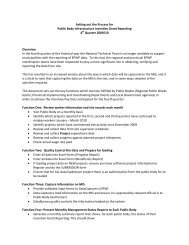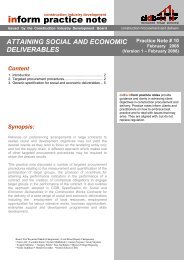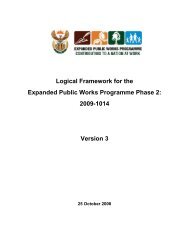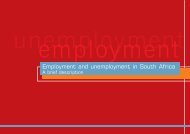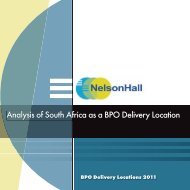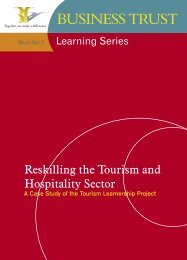Evaluation of the Monyetla Work Readiness ... - Business Trust
Evaluation of the Monyetla Work Readiness ... - Business Trust
Evaluation of the Monyetla Work Readiness ... - Business Trust
You also want an ePaper? Increase the reach of your titles
YUMPU automatically turns print PDFs into web optimized ePapers that Google loves.
5.4 Placement <strong>of</strong> 70% <strong>of</strong> learners in employment on completion <strong>of</strong> <strong>the</strong>skills programmeKey to <strong>the</strong> success <strong>of</strong> <strong>the</strong> model is <strong>the</strong> requirement that 70% <strong>of</strong> learners be placed in employmenton completion <strong>of</strong> <strong>the</strong> skills programme. The evaluation found that training providers that kept <strong>the</strong>irinvolvement going with learners in terms <strong>of</strong> providing <strong>the</strong>m support while <strong>the</strong>y are hosted byemployers had <strong>the</strong> most successful learners that were given longer-term contracts because <strong>the</strong>yemployers found <strong>the</strong>m to be <strong>the</strong> most work-ready after <strong>the</strong> project’s allocated time frames.The placement <strong>of</strong> learners currently exceeds <strong>the</strong> expected 70% benchmark. The programmemanaged to produce an overall placement rate <strong>of</strong> 89.99% out <strong>of</strong> <strong>the</strong> 1,129 learners that finished <strong>the</strong>programme and were found to be competent. The current results are positive as 41% <strong>of</strong> consortiathat completed <strong>the</strong> skills programme posted a 100% placement rate. Employers who had been privyto <strong>the</strong> recruitment process also posted high placement rates.Permanent or longer-term placement <strong>of</strong> learners should have a time limit as <strong>the</strong> transition periodbetween completing <strong>the</strong> programme and job placement would mean that learners are sitting aroundand possibly getting anxious and losing hope. Demand for learners should be primarily based on aneed identification to protect learners from <strong>the</strong> possibility <strong>of</strong> getting skilled with no employmentprospects.This issue should be examined in light <strong>of</strong> data relating to portability <strong>of</strong> <strong>the</strong> learnership or skillsprogramme. If fur<strong>the</strong>r research points out that <strong>the</strong> learnership or skills programme is highly portable<strong>the</strong>n <strong>the</strong> indication <strong>of</strong> a higher placement rate would suffice. This would give learners a betterchance <strong>of</strong> seeking employment once <strong>the</strong>y are out <strong>of</strong> this programme as <strong>the</strong>y would be having aqualification that <strong>the</strong>y can <strong>the</strong>n use to hunt for jobs.5.5 Nature <strong>of</strong> employment contracts entered into by learnersMost <strong>of</strong> <strong>the</strong> learners had entered into 3 month contracts that where subject to review. Inbound callcentres and host employer led consortia seem more likely to give learners permanent contracts thanoutbound call centres and lead employers.A study needs to be undertaken after a minimal period <strong>of</strong> 6 months (post-completion) on learneremployment to establish <strong>the</strong> nature <strong>of</strong> employment contracts entered into, and expectations <strong>of</strong>learners when entering into contracts. The general perception is that <strong>the</strong> call centre industry hashigh attrition rates, and this perception is what could be driving <strong>the</strong> employers to give short termcontracts, and also for agents to be consistently looking elsewhere. It needs to be established as towho drives <strong>the</strong> attrition, that is; employers or employees. Once established, policy or guidelines canbe formulated on how to counter this, so as to seek for stability in <strong>the</strong> call centre environment. Thecall centre industry also needs to be marketed in schools as a stable and opportunistic primarycareer path ra<strong>the</strong>r than as a secondary employment option.5.6 Provision <strong>of</strong> unemployed South Africans with entry level skills tobecome Contact Centre agentsThe model achieved and exceeded its objective <strong>of</strong> training 1,000 unemployed learners. Learners havea high probability <strong>of</strong> entering into employment within <strong>the</strong> <strong>Monyetla</strong> consortia model after successfulcompletion <strong>of</strong> <strong>the</strong> programme, and <strong>the</strong> placement rates currently stand at 89.99%. Learners who arenot employed within <strong>the</strong> <strong>Monyetla</strong> programme need to be tracked to ascertain if <strong>the</strong>y indeed areable to find employment in <strong>the</strong> BPO&O sector or elsewhere in <strong>the</strong> service sector <strong>of</strong> <strong>the</strong> economy.The programme needs to differentiate and categorise between Inbound and Outbound debtcollection, outbound sales and <strong>of</strong>fshoring, as <strong>the</strong> skills requirements have been shown to besufficiently different for each <strong>of</strong> <strong>the</strong>se fields. The distinction will impact on <strong>the</strong> entry requirements <strong>of</strong>both categories. It was revealed that this programme in particular was highly suitable for <strong>the</strong> Inbound50



